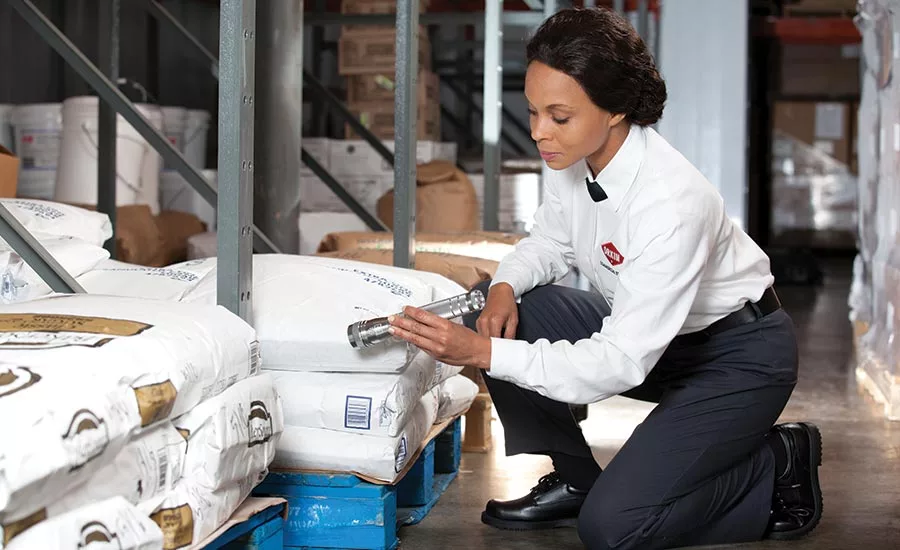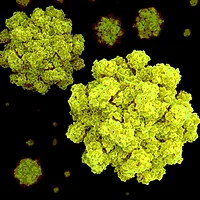Pest Control
A good pest control program can help protect the bottom line

Depending on the results of visual inspections, pesticides and other control steps beyond traps may be required.
Photo courtesy of Orkin

Several different models of rodent monitoring devices are available. Monitors with remote tracking have a sensor that sends an alert when pest activity is detected. Electronic monitoring systems can provide 24/7 alerts for pest activity. Sensors are placed around the facility and can be monitored on a tablet.
Photo courtesy of Bayer U.S.

Monitoring traps provide early warning signs of a problem and help determine whether a pest management program is working.
Photo courtesy of McCloud Services

Pest proofing for windows, vents, sewers and doors—like these dock door screens—can help keep pests outside.
Photo courtesy of McCloud Services
As temperatures rise outside, so do the problems with insects and pests. At food and beverage processing facilities, the presence of pests can threaten the health and safety of products, customers and employees. A pest problem also can affect a plant’s reputation and its bottom line—from having to discard a batch of compromised product to fines for noncompliance.
“Pest management is a partnership between the provider (or in-house team) and everyone else at the site,” says Chelle Hartzer, entomologist and technical services manager, Orkin. “Frontline employees need to know what to look for and whom to report it to. The professional needs to communicate sanitation and other issues to the sanitation and quality teams. Maintenance departments need to be involved in fixing exclusion points. So whatever the pest, whatever the issues, good communication is essential.”
Other considerations for a pest control program include regulatory elements, new technology and overall site management.
Rules, regulations and audits
Facilities need to be aware of the various rules related to pest management programs and the food processing industry, including those specific to compliance by the pest management firm or applicator, according to Patricia Hottel, technical director at McCloud Services.
The primary federal law is the Federal Insecticide, Fungicide and Rodenticide Act (FIFRA), which regulates pesticide use.
“It is the foundation for state regulations, requiring certification of pesticide applicators and registration of products,” says Hottel. “Some state regulations will require specific licensing of pest management professionals in a food processing category.”
Federal regulations that relate to food processing and pest management include:
- Food Safety Modernization Act (FSMA)
- Food, Drug and Cosmetic Act
- Current Good Manufacturing Practices
- USDA’s National Organic Program (for firms marketing products as organic certified)
- USDA’s Meat and Poultry Inspection Program (meat and poultry facilities)
Aside from these government regulations, there are also third-party audits to consider, says Hartzer. These include internal, supplier and vendor audits.
Looking for quick answers on food safety topics?
Try Ask FSM, our new smart AI search tool.
Ask FSM →
“Pest management professionals need to be aware of all those regulations and how they may apply to their procedures within a facility. Specific to pest management, we follow all pesticide labels, which are regulated by the EPA, and any state regulations that may apply,” Hartzer says.
Hottel adds, “Lack of effective pest proofing ranks high among the annual FDA list of top citations each year, even though it should be a main focus of the food industry overall and the pest management professionals who serve it.”
Prevention by exclusion
To prevent pests, which Hottel says is the most critical component of the facility’s pest management program, a strong exclusion program is needed. Pests most commonly enter a facility in one of three ways: on shipments, from the exterior environment or with employees.
“Many of our pest issues start on the outside, so if the structure can be sealed up as well as possible, we can keep the pests on the outside,” Hartzer says.
To keep pests from entering via shipments, vetting vendors and inspecting incoming goods is crucial.
“A facility’s receiving staff needs to be trained regarding how to perform an effective inspection when shipments arrive,” Hottel says.
To prevent pests from slipping into the building, she recommends keeping doors closed when not in use and using effective pest proofing for doors, windows, vents and sewers. “Pests like drain flies and American cockroaches are often associated with sewers, and this route of pest entry can be overlooked.”
Reducing conditions that encourage pests near the structure is also important.
“Focus on sanitation to reduce exterior food sources,” Hottel says. “Exterior lights can attract pests to a structure, and lighting that is least attractive to insects should be selected.”
Landscaping and vegetation choices can also impact pest activity, she says. Fruit- and seed-bearing plants are not desirable because they can provide food for pests. Plants with dense foliage can provide cover or a home.
Lastly, pests can be brought into the facility by staff members. This is the most common route in for German cockroaches and bed bugs, Hottel notes.
Mitigation
If pests gain access despite a facility’s exclusion program, prompt recognition of the issue is needed. This can be facilitated by monitoring traps and doing visual inspections, Hottel says.
“The earlier a pest problem is found, the easier it is to control. It is also critical to limit the availability of food, water and harborage for these pests,” she says.
Hartzer concurs and says that inspection is key.
“There are typically a lot of employees in a facility all day, so they are a great set of eyes to use,” she says. “If they know what to look for (pests, evidence of pests, sanitation issues, etc.) and they report that, issues can be found and treated when they are still small and isolated.”
Peter Jardine, strategic marketing lead, digital pest management, Bayer U.S., says that electronic monitoring, especially for rodents, can free up time for the service provider to conduct more thorough integrated pest management inspections, but sensitive end clients want more than trap checking from their service providers.
“Better pest management, food safety and audit readiness require a fundamental shift in how services are delivered and how new technology is utilized,” Jardine says. “Food and beverage manufacturers and other sensitive businesses need to hire the best service providers, who are well-trained and embrace new technology.”
Preventing an infestation is especially difficult in a processing plant because a lot of food is around.
“But if the amount of food and access to that food is reduced, pests won’t have the resources they need to develop and survive,” Hartzer says.
Hottel says that a detailed sanitation program and a strong structural maintenance regiment are needed. Monitoring via traps and inspections can validate the success of a pest control program. If monitoring and inspection reveal a problem, then pesticides and other control steps might be needed. Coordinating the necessary steps depends on strong communication between the pest management firm and the processor, especially when it comes to ensuring food safety.
“They don’t want consumers to question whether their product is safe to feed to their families,” Hottel says. “Food safety is a critical part of what they do, and a strong pest management program is an integral part of food safety assurance.”
New technology and services
Electronic monitoring devices, many of which are currently on the market for tracking rodents, are an exciting new technology, Hottel says.
“Additional devices for the remote monitoring of stored-product insects and other insects are in testing. These devices can provide 24/7 alerts regarding pest activity. Real-time alerts provide data uncovering the root cause of a pest problem and can lead to long-term solutions,” she says.
These devices are contributing new information on pest behavior and control efforts, which can help reduce the monitoring inspection frequency, allowing more time for visual inspections and other services.
Several different models are available. Remote electronic monitors have a sensor that sends an alert when pest activity is detected. The pest management professional receives the alert by text or email.
“Equipment needs will vary, but typically there is a trap or station, sensor, hub and device to receive the alert (phone, tablet or computer),” Hottel says. “The type of traps used varies by system, with some manufacturers offering sensors with a wide range of trap or station options.”
Some manufacturers offer a sensor option without a trap or station altogether. Some systems come equipped with the sensor embedded in the trap, while others have a detachable sensor. Costs vary, and most companies charge for the sensor upfront and require a recurring monthly fee to cover sensor connectivity and transmission.
Jardine says that the Bayer rodent monitoring system is relatively new to the market, launched about a year ago.
“It is a turnkey subscription service that is available via licensed pest control companies or direct to end customers who manage an in-house program. The cost is dependent on the number of monitored locations, facility specifics and complexity,” he explains.
When it comes to data collection and recordkeeping for pest management, knowing what pests are present and in what numbers helps identify and solve problems, Hartzer says.
“For example, if we know that roof rats are an issue, we start looking up, but if we know it is Norway rats, we know to start looking down for burrows.”
Identifying the pest helps control experts evaluate its feeding and habitat preferences.
“Knowing what those populations are doing also gives us valuable information,” says Hartzer. “For example, if we know fruit fly numbers are increasing, we can look for the food source (wet organic material) or maybe a door that has been left open. Alternately, if we see pest numbers decreasing, we can often attribute that to a corrective action that is working.”
Electronic reporting has helped streamline and improve pest control efforts. Pest management professionals can scan devices, input pest numbers and report conditions that are conducive to infestations. Because that information is recorded electronically, reports can be quickly and easily provided to processors to help make decisions about the best course of action.
“While the devices and products we use haven’t changed too much, the way a professional uses them and responds to the information gathered from them has been improved,” says Hartzer.
The endgame
Prevention will become even more effective as new technology evolves, Hottel notes.
“The ability to implement these new technologies will depend on a willing food industry collaboration,” she says. “Communication and strong partnerships are critical to achieving success under current programs and with these new technologies.”
Remember that all pests need the same thing we do: food, water and shelter. Orkin’s Hartzer says that if you “think like a pest” sometimes and see things from their point of view, you may notice much more than previously. The job isn’t easy, she points out.
“It takes a lot of tools, knowledge and hard work, and most providers strive to provide the best service they can. We know that we have a part to play in food safety. The facilities we work with may be producing the food on our families’ tables tonight.”
For more information:
Bayer: www.beyondsmarterbusiness.com
McCloud Services: www.mccloudservices.com
Orkin: www.orkin.com




.webp?t=1721343192)

